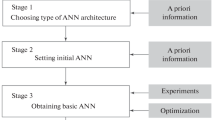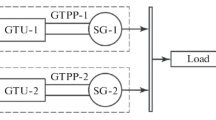Abstract
The possibilities of using neural network technologies for synthesizing new and improving existent gas-turbine plant (GTP) control systems are considered. Modern gas-turbine plant control systems are often developed on the basis of aviation automatic control systems, without taking into account the peculiarities of load changes in electricity generation. As a result, frequency-related quality indicators of electricity, such as maximum deviation and recovery time, do not always meet requirements that have been set out. This study is aimed at improving the quality of generated electricity. A list of different disturbances that can arise in an electric power system is provided, as well as the results of using the neural network model of a GTP to optimize the parameters of the gas-turbine unit adjuster.
Similar content being viewed by others
Explore related subjects
Discover the latest articles, news and stories from top researchers in related subjects.Avoid common mistakes on your manuscript.
The development of power engineering makes it necessary to adopt modern techniques of automatically controlling generative modules, which are often based on converted aircraft engines and operated in various isolated or open power supply systems. The drawback in this case is the use of conventional control techniques and devices, which are usually designed by slightly upgrading or, more precisely, readjusting aviation prototypes. The operational inefficiency of control devices in low- and medium-capacity power plants degrades the quality of generated electricity, as well as the reliability, effectivity, and ecofriendliness of switching from natural oil-associated gas to electricity and calorific power.
For this reason, comprehensive studies in the field of using artificial intelligence, in particular, neural networks and neural network models for integrally managing such areas as energy production, distribution, conservation, reliability, and safety, are important. This article considers the application of neural network models of gas-turbine plants (GTPs) in control system testing and adjustment.
OPERATIONAL PECULIARITIES OF GAS-TURBINE PLANTS
To modify existing and create new advanced automatic control systems (ACSs) for gas-turbine units (GTUs) that are parts of GTPs, it is necessary to take into account the influence of the electric power system (EPS). Gas-turbine plants are often used to cover peak loads and supply electricity to remote users. Various operating situations at GTPs are characterized by different nonlinear load changes. A list of standard GTP disturbances [2] can be formed on the basis of statutory documents with guidelines taken into account [1].
Individual power plants used as parts of a low-capacity generative network often run afoul of each other, which largely nullifies the strengths of the network of small energy modules as a highly reliable power supply system. For this reason, each generative module must continuously see and preliminarily evaluate the current operational situation and predict the behavior of the system, i.e., manifest properties typical of artificial intelligence.
This development of EPSs is aimed at intellectualizing control over gas-turbine plants that are operate in a network and exchange signals with each other (control signals through the control system communication lines and disturbing signals through the power grid). Intellectualizing of the control processes is aimed at improving the quality of electricity in the nodes of a power supply system and for the user so as to ensure a more reliable transmission and distribution of electricity, appropriately use natural resources by promptly managing backup capacity, and endow the power supply system with characteristics typical of highly reliable systems.
For this reason, it is necessary to use an artificial neural network for designing an environment model of acceptable precision and then use this model for adjusting the parameters of GTP regulators and organizing their interaction.
To design an ACS and consider load changes, it is necessary to use a set of various models that allow analyzing characteristic operational modes interrelated in a network of low- and medium-capacity GTPs, as well as take into account the influence of various disturbances in the power grid and operating situations on the quality of generated electricity, power supply reliability, and appropriate distribution of available resources.
AREA OF APPLICATION OF NEURAL NETWORK MODELS OF GAS-TURBINE PLANTS
At present, ACSs for GTPs are built on the basis of aviation prototypes with minor upgrades and adjustments for considering basic nonlinearities in control circuits; in this case, the available range of techniques from the modern theory of automatic control is inadequate. This situation is aggravated by the need for analyzing the dynamics across an entire integrated structurally complex EPS that includes separate energy modules and other interdependent components, which is a task that is hard to organize and hard to manage for analysis. It has been proposed to resolve the indicated controversy stems on the basis of the development of new control techniques and algorithms, with control over GTUs at GTPs being provided taking into account the behavior of the entire structure of the EPS on the basis of neural modeling. This approach will allow studying and taking into account, first, the whole diversity of operating situations in the EPS and, second, the whole range of advanced techniques from the automatic control theory as applied to individual energy modules in operating situations emerging in the EPS.
In view of the foregoing, neural networks will allow
• developing a set of neural network models that reflect the behavior of interconnected gas-turbine plants in various operating situations in the electricity distribution and consumption system;
• using neural network models to develop a procedure for adjusting GTP GTU control system regulators, which will allow making the adjustment of such systems and their commissioning a much more rapid and simpler process; and
• developing a procedure of controlling GTP GTUs by means of neural network models operated in real time.
In addition to intellectualizing the control processes proper, neural network models allow accelerating and simplifying the adoption of upgrades and innovations for controlling GTP GTUs, because this makes it unnecessary to have direct access to an actual facility or unit.
USING NEURAL NETWORK MODELS TO ADJUST GTU ACS
The considered approach allowed developing neural network models of GTPs for various operating situations [3–7]. The case that we will consider as an example is the transition obtained with the help of a neural network GTP model for a stepwise change in symmetrical electric load on the part of the EPS. For the results of comparing the operation of the neural network (NN) model and the facility at standard ACS settings, see Figs. 1 and 2.
Search techniques [8] based on the NN GTP model have helped to derive new parameters for the standard governor of the free GTU turbine. For transitional processes with these settings, see Figs. 3 and 4.
The setting of parameters for the GTU ACS in the NN GTP model has made it possible to obtain a significantly shorter transitional process for the free turbine rotation frequency and, therefore, a much shorter period in which the electricity generated at the GTP deviates in frequency from the GOST (State Standard) requirements.
The results show that neural networks allow modeling, analyzing, and designing a GTU ACS to create a highly reliable power supply system, the components of which can be embedded in the standard GTP ACS subsystems.
REFERENCES
Venikov, V.A., Perekhodnye elektromekhanicheskie protsessy v elektricheskikh sistemakh (Transitional Electromechanical Processes in Electrical Systems), Moscow: Vysshaya Shkola, 1985.
Kavalerov, B.V. and Basargin, Sh.D., Unified transient quality indicators for automated testing of gas turbine power plants, Fundam. Issled., 2015, no. 12-3.
Kilin, G.A. and Kavalerov, B.V. A neural network mathematical model for automated testing of an automatic control system for small- and medium-size power gas turbine power plants, Sovrem. Naukoemkie Tekhnol., 2019, no. 2.
Kavalerov, B.V. and Kilin, G.A., Electric gas-turbine unit control system automation tuning based on neural network models, Inf.-Izmerit. Upr. Sist., 2018, no. 9.
Zhdanovskii, E.O., Kavalerov, B.V., and Kilin, G.A., Development of neural network model of gas turbine power plant for controllers of gas-turbine installations, Fundam. Issled., 2016, no. 12-3.
Kilin, G.A., Kavalerov, B.V., and Masyagin, E.D., The choice of neural network architecture to design a mathematical model of a gas turbine power plant, Materialy Mezhdunarodnoi nauchno-prakticheskoi konferentsii “Aktual’nye problemy elektromekhaniki i elektrotekhnologii” (Proc. Sci.-Pract. Conf. “Current Problems in Electromechanics and Electrical Technologies”), Yekaterinburg: Ural. Fed. Univ., 2017.
Kilin, G.A. and Kavalerov, B.V., Use of neural network technologies in mathematical models of the gas-turbine installation–alternator system, Materialy II Mezhdunarodnoi nauchno-tekhnicheskoi konferentsii “Avtomatizatsiya v elektroenergetike i elektrotekhnike” (Proc. II Int. Sci.-Tech. Conf. “Automation in Electrical Energetics and Electrical Engineering”), Perm: Permsk. Nats. Issl. Politekhn. Univ., 2016.
Kilin, G.A., Kavalerov, B.V., and Odin, K.A., Use of genetic algorithm for adjustment and optimization of control systems of gas turbine installations, Vestn. Permsk. Nats. Issl. Politekhn. Univ. Elektrotekhn., Inf. Tekhnol., Sist. Upr., 2014, no. 2.
Funding
This study was financially supported by the Russian Foundation for Basic Research and Perm krai as part of scientific project no. 19-48-590012.
Author information
Authors and Affiliations
Corresponding author
Additional information
Translated by S. Kuznetsov
About this article
Cite this article
Kavalerov, B.V., Bakhirev, I.V. & Kilin, G.A. Using Neural Networks in Controlling Low- and Medium-Capacity Gas-Turbine Plants. Russ. Electr. Engin. 90, 737–740 (2019). https://doi.org/10.3103/S106837121911004X
Received:
Revised:
Accepted:
Published:
Issue Date:
DOI: https://doi.org/10.3103/S106837121911004X








